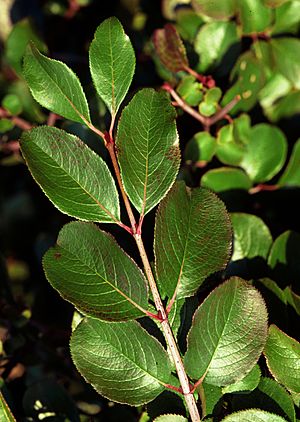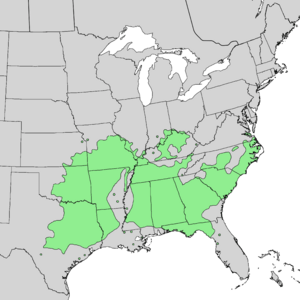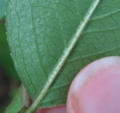Rusty blackhaw facts for kids
Quick facts for kids Rusty blackhaw |
|
|---|---|
 |
|
| Conservation status | |
| Scientific classification | |
| Genus: |
Viburnum
|
| Species: |
rufidulum
|
 |
|
| Generalized natural range of Viburnum rufidulum | |
The rusty blackhaw (scientific name: Viburnum rufidulum) is a type of flowering shrub or small tree. It's also known by other names like blue haw or southern black haw. This plant is very common in parts of the Eastern and Central United States. It's loved for its pretty flowers and colorful leaves in the fall. Its fruits are also a favorite snack for some birds.
Contents
What Does It Look Like?
Leaves and Branches
The rusty blackhaw has tough, leathery leaves that fall off in autumn. This means it's a deciduous plant. The leaves grow in pairs opposite each other on the branch. They are usually about 0.5 to 3 inches long and 1 to 1.5 inches wide.
The stems that connect the leaves to the branch are called petioles. These petioles have tiny "rusty" hairs and sometimes small ridges or "wings." The edges of the leaves are saw-toothed, which is called "serrate." In the fall, the leaves turn beautiful shades of bronze and red.
The plant's Twigs can be reddish-brown or gray. When they are young, the twigs are hairy, but they become smoother as they get older.
Bark
The bark of the rusty blackhaw looks a bit like the bark of a flowering dogwood tree. It can be reddish-brown to almost black. On older, larger trunks, the bark forms small, blocky plates.
Flowers and Fruit
The rusty blackhaw blooms in April and May. It produces creamy white flowers that grow in large clusters, sometimes up to six inches wide. These flowers are "perfect," meaning each flower has both male and female parts.
After the flowers, the plant grows fruits. These fruits are dark blue or purple and have a slightly waxy coating, which is called "glaucous." They are round or oval-shaped and are a type of drupe, meaning they have a single hard seed inside. The fruits ripen in mid to late summer. They are safe to eat and some people say they taste like raisins. Birds also love to eat them!
How to Tell It Apart
The rusty blackhaw is very similar to another plant called Viburnum prunifolium, also known as the blackhaw. The easiest way to tell them apart is by looking at the petioles. The rusty blackhaw's petioles have those special rusty hairs, while the blackhaw's petioles do not.
Where Does It Grow?
The rusty blackhaw likes dry places and usually grows in areas that are not higher than 750 meters (about 2,460 feet) above sea level.
You can find this plant in many states across the central and eastern United States. These include Alabama, Arkansas, Florida, Georgia, Illinois, Indiana, Kansas, Kentucky, Louisiana, Mississippi, Missouri, North Carolina, Ohio, Oklahoma, South Carolina, Tennessee, Texas, Virginia, and West Virginia.
Uses
Sometimes, the rusty blackhaw is planted in gardens or parks because it is a very attractive ornamental plant. People enjoy its pretty flowers, colorful fall leaves, and the fruits that attract birds.
Images for kids




